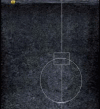Preclinical evaluation of acoustic radiation force impulse measurements in regions of heterogeneous elasticity
- PMID: 27599889
- PMCID: PMC5040141
- DOI: 10.14366/usg.16024
Preclinical evaluation of acoustic radiation force impulse measurements in regions of heterogeneous elasticity
Abstract
Purpose: The purpose of this study was to compare the reliability of ultrasound-based shear wave elastography in regions of homogeneous versus heterogeneous elasticity by using two different probes.
Methods: Using acoustic radiation force impulse (ARFI) elastography, we measured the shear wave velocity (SWV) in different lesions of an elastography phantom with the convex 4C1 probe and the linear 9L4 probe. The region of interest (ROI) was positioned in such a way that it was partly filled by one of the lesions (0%, 25%, 50%, 75%, and 100%) and partly by the background of the phantom (100%, 75%, 50%, 25%, and 0%, respectively).
Results: The success rate was 98.5%. The measured value and the reference value of SWV correlated significantly (r=0.89, P<0.001). Further, a comparison of the two probes revealed that there was no statistical difference in either the mean or the variance values. However, the deviation of SWV from the reference was higher in the case of the 9L4 probe than in the case of the 4C1 probe, both overall and in measurements in which the ROI contained structures of different elasticity (P=0.021 and P=0.002). Taking into account all data, for both probes, we found that there was a greater spread and deviation of the SWV from the reference value when the ROI was positioned in structures having different elastic properties (standard deviation, 0.02±0.01 m/sec vs. 0.04±0.04 m/sec; P=0.010; deviation from the reference value, 0.21±0.12 m/sec vs. 0.38±0.27 m/sec; P=0.050).
Conclusion: Quantitative ARFI elastography was achievable in structures of different elasticity; however, the validity and the reliability of the SWV measurements decreased in comparison to those of the measurements performed in structures of homogeneous elasticity. Therefore, a convex probe is preferred for examining heterogeneous structures.
Keywords: Elasticity imaging techniques; Heterogeneity; Phantoms, imaging; Transducers; Ultrasonography.
Conflict of interest statement
No potential conflict of interest relevant to this article was reported.
Figures




Similar articles
-
Does standoff material affect acoustic radiation force impulse elastography? A preclinical study of a modified elastography phantom.Ultrasonography. 2018 Apr;37(2):140-148. doi: 10.14366/usg.17002. Epub 2017 Jul 28. Ultrasonography. 2018. PMID: 29032665 Free PMC article.
-
Variability of shear wave velocity using different frequencies in acoustic radiation force impulse (ARFI) elastography: a phantom and normal liver study.Ultraschall Med. 2013 Jun;34(3):260-5. doi: 10.1055/s-0032-1313008. Epub 2012 Sep 21. Ultraschall Med. 2013. PMID: 23023455
-
Comparison of Acoustic Radiation Force Impulse (ARFI) Elastography Measurements with the 4C1 Transducer to the 6C1HD Transducer: A Phantom and Patient Study.Ultraschall Med. 2016 Oct;37(5):477-481. doi: 10.1055/s-0041-107974. Epub 2016 Mar 1. Ultraschall Med. 2016. PMID: 27112625 English.
-
Reliable measurement by virtual touch tissue quantification with acoustic radiation force impulse imaging: phantom study.J Ultrasound Med. 2012 Aug;31(8):1239-44. doi: 10.7863/jum.2012.31.8.1239. J Ultrasound Med. 2012. PMID: 22837288
-
Quantitative Shear Wave Velocity Measurement on Acoustic Radiation Force Impulse Elastography for Differential Diagnosis between Benign and Malignant Thyroid Nodules: A Meta-analysis.Ultrasound Med Biol. 2015 Dec;41(12):3035-43. doi: 10.1016/j.ultrasmedbio.2015.08.003. Epub 2015 Sep 12. Ultrasound Med Biol. 2015. PMID: 26371402 Review.
Cited by
-
The Clinical Value of Multimodal Ultrasound for the Differential Diagnosis of Hepatocellular Carcinoma from Other Liver Tumors in Relation to Histopathology.Diagnostics (Basel). 2023 Oct 23;13(20):3288. doi: 10.3390/diagnostics13203288. Diagnostics (Basel). 2023. PMID: 37892109 Free PMC article.
-
Does standoff material affect acoustic radiation force impulse elastography? A preclinical study of a modified elastography phantom.Ultrasonography. 2018 Apr;37(2):140-148. doi: 10.14366/usg.17002. Epub 2017 Jul 28. Ultrasonography. 2018. PMID: 29032665 Free PMC article.
-
2-dimensional shear wave elastography: Interobserver agreement and factors related to interobserver discrepancy.PLoS One. 2017 Apr 17;12(4):e0175747. doi: 10.1371/journal.pone.0175747. eCollection 2017. PLoS One. 2017. PMID: 28414822 Free PMC article.
-
Prospective Validation of Intra- and Interobserver Reproducibility of a New Point Shear Wave Elastographic Technique for Assessing Liver Stiffness in Patients with Chronic Liver Disease.Korean J Radiol. 2017 Nov-Dec;18(6):926-935. doi: 10.3348/kjr.2017.18.6.926. Epub 2017 Sep 21. Korean J Radiol. 2017. PMID: 29089825 Free PMC article.
References
-
- Goertz RS, Amann K, Heide R, Bernatik T, Neurath MF, Strobel D. An abdominal and thyroid status with Acoustic Radiation Force Impulse Elastometry: a feasibility study: Acoustic Radiation Force Impulse Elastometry of human organs. Eur J Radiol. 2011;80:e226–e230. - PubMed
-
- Mei M, Ni J, Liu D, Jin P, Sun L. EUS elastography for diagnosis of solid pancreatic masses: a meta-analysis. Gastrointest Endosc. 2013;77:578–589. - PubMed
-
- Stock KF, Klein BS, Vo Cong MT, Sarkar O, Romisch M, Regenbogen C, et al. ARFI-based tissue elasticity quantification in comparison to histology for the diagnosis of renal transplant fibrosis. Clin Hemorheol Microcirc. 2010;46:139–148. - PubMed
-
- Barrault C, Roudot-Thoraval F, Tran Van Nhieu J, Atanasiu C, Kluger MD, Medkour F, et al. Non-invasive assessment of liver graft fibrosis by transient elastography after liver transplantation. Clin Res Hepatol Gastroenterol. 2013;37:347–352. - PubMed
LinkOut - more resources
Full Text Sources
Other Literature Sources

